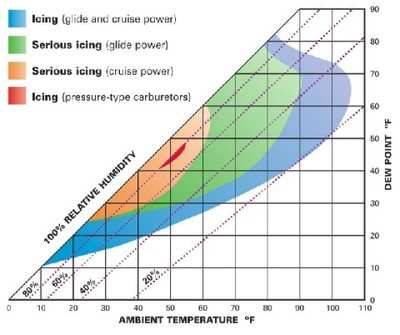Wed, Jul 01, 2009
Summer Means Higher Humidity, And A Chance For Ice
 The FAA has issued
a Special Airworthiness Information Bulletin designed to
inform pilots of the potential hazards associated with carburetor
icing. For now, this airworthiness concern is not considered an
unsafe condition that would warrant an AD, but is still a timely
reminder for summer flying.
The FAA has issued
a Special Airworthiness Information Bulletin designed to
inform pilots of the potential hazards associated with carburetor
icing. For now, this airworthiness concern is not considered an
unsafe condition that would warrant an AD, but is still a timely
reminder for summer flying.
The FAA says there were 212 accidents attributed to carburetor
icing between 1998 and 2007. Of these accidents,13 resulted in
fatalities. The certification requirements for carbureted airplanes
require that a heated source of air be provided as mitigation for
carburetor icing. The FAA and the Aircraft Owners and Pilots
Association (AOPA) have addressed the subject of carburetor icing
several times in various forms. Despite the certification
requirements, and the information provided by the FAA and AOPA, the
accident trend has remained fairly steady throughout the years.
Pilots should be aware that carburetor icing doesn’t just
occur in freezing conditions, it can occur at temperatures well
above freezing temperatures when there is visible moisture or high
humidity. Icing can occur in the carburetor at temperatures above
freezing because vaporization of fuel, combined with the expansion
of air as it flows through the carburetor, (Venturi Effect) causes
sudden cooling, sometimes by a significant amount within a fraction
of a second. Carburetor ice can be detected by a drop in rpm in
fixed pitch propeller airplanes and a drop in manifold pressure in
constant speed propeller airplanes. In both types, usually there
will be a roughness in engine operation. The graph below shows the
probability of carburetor icing for various temperature and
relative humidity conditions:

There are some steps a pilot can take to prevent, recognize, and
respond to carburetor icing. To prevent carburetor icing, the pilot
should:
- Assure the proper functionality of the carburetor heat during
the preflight check.
- Use carburetor heat on approach and descent when operating at
low power settings, or in conditions where carburetor icing is
probable.
To recognize carburetor icing, the warning signs are:
- A drop in rpm in fixed pitch propeller airplanes.
- A drop in manifold pressure in constant speed propeller
airplanes.
- In both types, usually there will be a roughness in engine
operation.
The pilot should respond to carburetor icing by applying full
carburetor heat immediately. The engine may run rough for short
time while ice melts. The FAA says these recommendations are
general suggestions. The pilot should consult the AFM or the
pilot's operating handbook for the proper use of carburetor
heat.
More News
19-Year-Old Pilot Was Attempting to Fly Solo to All Seven Continents On his journey to become the first pilot to land solo on all seven continents, 19-year-old Ethan Guo has hit a >[...]
From 2017 (YouTube Edition): A Quality LSA For Well Under $100k… Aeroprakt unveiled its new LSA at the Deland Sport Aviation Showcase in November. Dennis Long, U.S. Importer>[...]
Hazardous Weather Information Summary of significant meteorological information (SIGMET/WS), convective significant meteorological information (convective SIGMET/WST), urgent pilot>[...]
Aero Linx: Historic Aircraft Association (HAA) The Historic Aircraft Association (HAA) was founded in 1979 with the aim of furthering the safe flying of historic aircraft in the UK>[...]
"We would like to remember Liam not just for the way he left this world, but for how he lived in it... Liam was fearless, not necessarily because he wasn't afraid but because he re>[...]
 TikToker Arrested After Landing His C182 in Antarctica
TikToker Arrested After Landing His C182 in Antarctica Classic Aero-TV: Versatile AND Practical - The All-Seeing Aeroprakt A-22 LSA
Classic Aero-TV: Versatile AND Practical - The All-Seeing Aeroprakt A-22 LSA ANN's Daily Aero-Term (06.27.25): Hazardous Weather Information
ANN's Daily Aero-Term (06.27.25): Hazardous Weather Information ANN's Daily Aero-Linx (06.27.25)
ANN's Daily Aero-Linx (06.27.25) Aero-News: Quote of the Day (06.27.25)
Aero-News: Quote of the Day (06.27.25)




